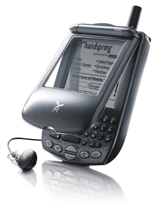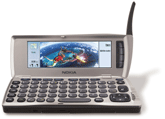The long-promised convergence of wireless computing and communications in one shiny little box that hangs lightly on your belt looks increasingly like those two lines that incline toward each other near the horizon, holding hope for a rendezvous in a place just beyond.But after a few years of oversold personal digital assistants, smart phones that seem brick-heavy next to your cell, and the amazing rise of the BlackBerry (don't call it a pager!), convergence remains as troubled a union as the average Hollywood marriage.Some even wonder if computing and wireless communications should just go their separate ways. 'By and large, most end users want a good voice call, and they don't want dropped calls,' said Neil Strother, a senior analyst at InStat/MDR of Scottsdale, Ariz., who closely follows worldwide cell phone trends.Phones loaded with data modems and application software can take on the bugs and glitches of computers, he said, though phone-makers claim that isn't true anymore. In any case, sales speak for themselves: of the 430 million phones shipped worldwide last year, only 1 to 2 percent were smart phones, which Strother defines as having a PDA operating system such as Palm OS or Microsoft Pocket PC.But smart-phone technology isn't standing still. Major vendors have been beefing up their lines with 'world' phone transmitters that support the European, Asian and emerging North American frequencies for the Global System for Mobile Communications protocol, as well as its main competitor, Code Division Multiple Access.[IMGCAP(2)]They've been making more noise with a slew of significantly dumber phones that have basic organizer features and let you surf the Web, exchange e-mail, view short video clips and play games. These are the Web phones that took off in Japan. In recent months, they've taken on digital cameras for e-mailing photos and even shooting a short video. Multimedia Messaging Service (MMS) support has been added to many phones and the networks of carriers such as Cingular Wireless, making media-rich messaging a reality today.On the PDA side, the action has focused on emerging wireless standards. Palm Inc. recently followed the impressive cellular version of its new Tungsten line with the Tungsten C, which incorporates the IEEE 802.11b (WiFi) standard for wireless local-area networks. The unit's 64M of RAM and 400-MHz speed make it the most powerful Palm OS handheld to date, the company claims (see story, Page 32). WiFi lets PDAs pump data faster than on cellular, but WiFi hotspots aren't as ubiquitous, and cellular carriers are starting to beef up their data infrastructures with high-speed General Packet Radio Service for GSM and 1xEV-DO for CDMA.Conversely, some PDAs now have phones, including the Tungsten and several Sony Clie models. So do most of the newer BlackBerry models from Research in Motion Ltd., which recently introduced a new, slimmer model called the 6210 that also adds a much-requested feature: the ability to read e-mail attachments such as Adobe Acrobat Portable Document Format files.[IMGCAP(3)]Then there's Handspring, maker of arguably the most converged device of all, the Treo line, which combines a BlackBerry-like thumb keyboard with tight links between PDA contact files and voice call control. Despite financial struggles, the company is moving forward, most recently with the Treo 270 world phone and the Treo 300, the latter designed expressly for Sprint Corp.'s high-speed data network.Vendors of all three types, but especially PDAs, have responded to the recent demand among government agencies for better security. Virtual private network software is available on some models, for example, and Secure Sockets Layer encryption is nearly ubiquitous. Analysts say one reason the BlackBerry has become popular in government is it has the tightest end-to-end security, with no gaps between the wireless carrier and the organization's mail servers'a well-publicized but overhyped vulnerability of cellular networks.Not surprisingly, even these lines will blur later this year, according to Research in Motion, when smart-phone vendors license BlackBerry back-end technology for messaging on their products. The BlackBerry platform also will become more open for development, letting agencies and software companies develop applications that run on the handhelds.Bluetooth, a short-range wireless standard, is becoming widely available on the newest devices. It has long been seen as a cable-replacement technology that makes it easier, for example, to print from a handheld. But it's actually enabling an emerging class of input peripherals for keyboard-starved phones, according to a Nokia Americas spokesman.Analysts and vendors point to obvious shortcomings. Phone-makers themselves admit that phone keypads and tiny'albeit typically color'screens don't cut it for real computing. In contrast, the BlackBerry's thumb keyboard has won over skeptics to become the standard for wireless messaging, imitated on products from Handspring and Palm.Phone addicts have resisted holding a bulky PDA up to their ears or fumbling with headsets.And WiFi sucks PDA batteries like Dracula drains blood from his victims, raising the risk that hybrid devices won't have enough power left for phone calls. 'It's really a technology that was built with laptops in mind,' said Alex Slawsby, an analyst at International Data Corp. of Framingham, Mass.Recognizing this, Palm and other vendors are offering power-boosting options such as battery sleds.The BlackBerry and its new'and only'direct competitor, Good Technology's G100, are likely the best choice if instant, secure, always-on enterprise e-mail is your killer app; these companies have the wide-area messaging and enterprise server infrastructure down pat.If voice is your choice, get a phone'a regular one without 'smart' features'and perhaps carry a PDA along with it.But if your needs tilt toward real computing in the field, only PDAs have the requisite processing power, RAM and screen size for the job.
Handspring's Treo 180, a hybrid PDA and phone, runs Palm OS and gives users a choice between a thumb keyboard and a Grafitti pen for input. It's priced at $249 plus service contract.
Research In Motion's BlackBerry 6510, priced at $500 plus service contract, is a wireless handheld with a phone and backlit thumb keyboard.
The 9210 Communicator from Nokia Americas is a hybrid PDA and phone with a color screen, 16M of RAM, plus 16M Flash and a QWERTY keyboard. It's priced at $400 plus a service contract.









